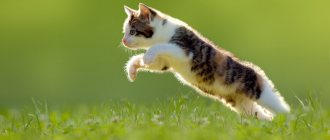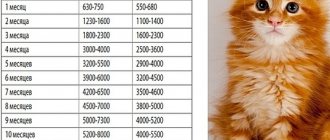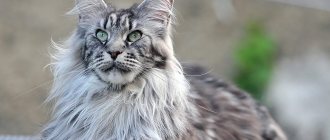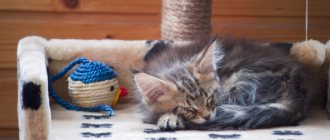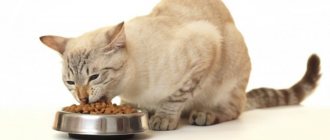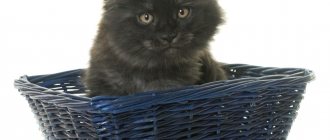How can you not worry about your kitten? He is so small and defenseless, he cannot tell his owner whether there is enough food or not. So the owner is trying: he constantly feeds the baby, because the poor thing is too thin.
What age is the baby? Three months? Great, we have to find out how much a kitten should weigh at 3 months. And after that, decide whether he is really skinny, or whether the owner decided so.
From birth to...
Before we get to our main task, let's talk about how cat babies gain weight.
Birth weight often does not reach 100 grams, unless we are talking about a large breed such as the Maine Coon. Kittens of these breeds weigh about 150 grams at birth.
During the first month of life, the baby gains weight 4-5 times its original weight. A one-month-old kitten already weighs 400-500 grams.
By the age of two months, its weight can be 600-700 g. Maine coons and other large breeds can weigh 900 g.
The normal weight of a kitten at 3 months is from 1200 to 1500 grams. But there are some factors to consider here. Which? We'll find out in the next subsection.
By month
At each age, a kitten’s nutrition has its own characteristics. Not only the portions and frequency of giving food change, but also its composition. Its future health depends on how well a cat eats in childhood. When a kitten is purchased from a breeder, he gives the owner the necessary recommendations on the pet’s nutrition that should be followed.
Natural food
Natural food for kittens and cats is chosen more often than industrial food. Some breeders raise babies on natural food for up to 2-3 months, and then gradually switch to industrial diets, since their use is more convenient for the owners.
Little kittens drink milk
from 1.5 to 2 months
The stomach and intestines of a one and a half month old kitten learn to digest food, and therefore the baby’s food should be easily digestible and not irritate the mucous membranes. Food is given liquid and semi-liquid.
Solid food is still prohibited during this period. If the cat has enough milk, then first the kitten is given fermented milk products with egg yolk. The boiled yolk is pounded and mixed with fermented baked milk or yogurt.
After the first week of such complementary feeding, they begin to give meat puree (if the cat does not have enough milk, then they begin to give puree at the same time as dairy products). It is prepared from lean boiled meat, which is ground in a blender and mixed with a small amount of broth to give the food the desired semi-liquid consistency. When the kitten begins to eat confidently enough, which usually happens closer to 2 months, you can give the meat without adding broth and grind it less finely.
Be sure to prepare liquid porridge. They are boiled in water or milk, which is diluted half with water. You can give kittens buckwheat, rice and oatmeal, after grinding them until a homogeneous mass with the consistency of fermented baked milk is obtained. The porridge should be prepared without salt and sugar. It is useful to add a little honey to it to enrich it with vitamins and minerals.
For your information! Kittens at one and a half months old need to change their water at least 2 times a day.
2 to 3 months
At this time, you can move on to feeding denser foods. For a two-month-old kitten, the boiled meat is already finely chopped, and grated carrots, pumpkin or cucumbers are added to it. Porridges are prepared in the same way as in the previous age with a large amount of liquid, but it is no longer necessary to grind the cereals too much. The porridge should remain liquid, and a homogeneous mass is no longer required.
Advice! Milk and dairy products should account for 50% of the diet.
It is impossible to reduce the number of feedings to less than 6. If the owner’s work schedule does not allow him to provide the pet with regular food, then it is necessary to resort to the free feeding method. In such a situation, the kitten should always have a small amount of fermented baked milk or kefir in its bowl so that it can eat as soon as it feels hungry. In this case, full feeding is carried out at least 4 times. This method is treated as an exception, therefore, if it is possible to feed the kitten regularly, it should not be used.
3 to 4 months
At this age, the kitten is already beginning to adapt to eating adult food. The amount of dairy products in his diet is reduced to ¼ of the total. Whole milk is gradually completely eliminated from the diet. This is due to the fact that by this age the enzyme that ensures the breakdown of lactose ceases to be produced, and therefore milk begins to cause digestive problems and diarrhea. Porridge is also cooked with plenty of water and the cereal is not ground. The meat is no longer cut so finely. Vegetables are still provided.
Whiskas dry food
4 to 5 months
The diet becomes the same as that of adult cats, but the supply of food still remains more frequent than theirs. The consistency of the food also differs.
It still shouldn't be very stiff. Porridges are prepared with a moderate amount of water, and the meat is cut quite coarsely. Among dairy products, preference is given to cottage cheese with a fat content of 5 to 9%.
There are cats that eat soft and liquid food all their lives. This is not a deviation. If the kitten, in the absence of pathologies, refuses solid foods, then you should simply continue feeding food with the same consistency as before.
5 to 6 months
The vast majority of a cat's diet consists of solid food. Porridge is prepared according to standard standards, as for humans. Little by little, the pet begins to be offered pieces of lean raw meat. Cats are carnivores, and they need this diet to maintain a healthy stomach. Otherwise, feeding remains the same as up to 5 months.
From 6 to 12 months
The main difference between a kitten’s diet at this age is the inclusion of a significant amount of raw meat in the diet. It should be at least 50% of the total volume of meat food. The rest of the diet is the same as before.
Industrial
You can feed a kitten with ready-made industrial food from an early age, since most reputable manufacturers have food for cats and products for babies in their lines.
1 to 2 months
During this period, feeding is carried out with special pates for kittens from a month to two months. They have a very delicate consistency that does not irritate the mucous membranes. Also during this period, cat milk substitutes are given if the cat does not have enough of it. The number of feedings per day is unchanged for both natural and industrial feeds. If the baby cannot yet start eating the pate because its consistency is not very liquid, then it should be diluted a little with boiled water. Gradually the amount of water is reduced so that by 2 months the pate is given in the form in which it is produced. If the pet eats food without adding water, then it is not required to use it, even at the very beginning of complementary feeding.
2 to 3 months
Dry kitten food is gradually added to the pate. They should definitely be soaked. This is required because the pet cannot yet fully chew hard pieces and there is a high risk that he will choke. The volume of soaked dry food should not exceed 20% of the total nutrition.
3 to 4 months
Pate for kittens is complemented by soft food, which is also intended for feeding babies. In addition, dry food is also given - slightly soaked at the beginning of the period, and dry at the end.
From 4 to one year
Pate is completely replaced with wet food. These can be portioned foods in bags or canned goods in jars. The latter option is cheaper, but after opening the product should be stored for no more than a day in the refrigerator, transferred to glass. Because of this, if the pet is a small one, jars may be inconvenient, since some of the food will remain uneaten and will have to be thrown away after a day. Dry food for kittens is no longer soaked.
From this moment onwards up to a year the diet remains the same. After 1 year, the cat becomes an adult, its active growth and development stops. From this age she should be given adult food. You need to choose a product from the same manufacturer as for the kitten. This will significantly speed up the period of your pet’s adaptation to the new diet. The cat should be switched to adult food gradually, replacing more and more of the kitten food with adult food every day for a week.
If you have spayed an older kitten, her diet should change. Read the special article on feeding sterilized cats.
Spiders for small kittens
Factors affecting weight
It all starts from the moment the cat is pregnant. It is no secret that the further development of a kitten, including its weight, is influenced by intrauterine formation. Did the fetus receive the required amount of vitamins and nutrients?
- Nutrition of the expectant mother is a key factor in the formation of the fetus and its subsequent development.
- The nutritional value of mother's milk plays an important role.
- Does the baby have enough milk? If not, then he may be slightly behind in physical development from more “well-fed” kittens.
- Number of brothers and sisters. The larger the litter, the harder it is for the cat to feed it.
- Nutrition after weaning. It is clear that a stray kitten, which knows the feeling of hunger from an early age, will weigh less than its domestic counterpart.
- Seals are larger than female cats, so they will weigh more.
The weight of a 3-month-old kitten depends on such seemingly not very significant factors.
What to feed a kitten: homemade food, dry or wet food
Many owners face a difficult choice when they try to decide what to feed their pet - homemade food or industrial food. Both types of feeding have pros and cons. In addition, a commercial diet involves dry food, wet food, or alternating the two.
The natural diet of a 3 month old kitten consists of:
- Whole milk.
- Boiled meat, peeled from skin and bones.
- Raw minced meat, previously frozen for 3-4 days.
- Homemade fermented milk products.
- Chicken egg yolk or quail eggs.
- Low-fat broths.
- A small amount of vegetables.
- Vitamin supplements.
- Greenery.
Benefits of homemade food:
- You can control the freshness and quality of the products.
- Natural food is more natural for cats, which is why most industrial food manufacturers advertise their products as being as close as possible to natural products.
- With the help of a natural diet, you can regulate the functioning of the kitten’s gastrointestinal tract.
- Any vitamins and supplements can be added to a natural diet.
Breed and weight
Two friends decided to get cats. One bought a Maine Coon, and the second decided on a Siamese kitten. The “kids” are the same age and are fed very well. But why does the Maine Coon look like a lynx? Plump, heavy, pleasant to touch. And a representative of the Siamese breed resembles a skeleton: skinny, disproportionately long, and you can count the ribs.
Because the breeds are completely different. And this means that the weight of a kitten at 3 months of one breed will be significantly different from another.
So that the owners are not afraid of the “wrong” weight of their pet, they need to know this:
- At the age of three months, the Maine Coon weighs 1700-2300 grams.
- A Scottish kitten at the same age will weigh 1000-1500 grams.
- A British baby weighs the same as a Scottish baby.
- A Siamese kitten barely reaches a weight of 1000 grams.
- Sphynxes can weigh from 800 to 1300 grams.
- Ordinary noble representatives of cats - from 700 to 1000 grams.
Water in the diet of a three-month kitten
Regardless of age, water plays a vital role in your pet's diet. At the age of 3 months, kittens are reluctant to drink water, or rather, they become accustomed to this procedure. Immediately after moving to a new home, the kitten does not drink water well because it is not used to it. Being close to its mother, the kitten received enough water from milk.
If you are planning to transfer your pet to industrial feeding, make sure that he knows how and willingly drinks water. Almost all commercial food contains preservatives that absorb water from the pet's gastrointestinal tract. This feature of industrial feeding can lead to the development of dehydration in a kitten within a few hours, if suddenly switched to dry food.
Pathology
How much should a kitten weigh at 3 months of age? From 700 to 2300 grams. It depends on the breed. The average weight ranges from 1200 to 1500 grams.
What if the pet exceeds its weight category? A slight excess cannot be called critical. 100 grams is nonsense. In the case when a pet looks more like a small ball than a cute kitten, we are talking about a pathological weight disorder. And what should the owner do?
First of all, have your pet examined by a veterinarian. Cats are prone to diseases, the symptom of which is weight gain. If the veterinarian rules out their development, then you will have to reconsider the pet’s diet. He also diagnoses obesity in the baby.
Same problem, only from the other side. The kitten does not weigh enough. But at the same time he is active, mobile, curious and has a good appetite. It wouldn't hurt to visit a veterinarian. Has the cat and dog doctor ruled out diseases? Great, people can be too thin too. They eat pretty well though. You should not try to fatten the kitten, let him eat as much as he wants.
Why monitor the development of newborn kittens?
It is very important to monitor how newborn kittens develop and know how best to care for babies at different stages of their growth. This will help get rid of many problems associated with animal health.
During the first three weeks of kittens' lives, mother cats themselves feed and care for them. However, control over the full and timely development of small pets is the responsibility of the owner. To do this, you need to regularly weigh the kittens, and also know when they open their eyes, when their first teeth are cut, when they begin to hear, walk and eat solid food.
Mother cat takes care of newborn kittens herself
Feeding and maintenance
We found out how much a kitten should weigh at 3 months. Now let's talk about how to feed the little furry little prankster. And how to care for it.
Let's start with nutrition. The owner needs to remember that a lot depends on a balanced diet. Please do not feed your baby with economy class kitten food. Yes, they are available and cheap. But the quality is lacking on both legs. Feeding a kitten this kind of food is the same as feeding a human child instant noodles. Is there much use in it? And how long will you be healthy enough to digest this crap?
What if you don’t have money for good food? He's expensive. Feed natural food, this is not a problem. Chicken and turkey are not the most expensive meats. Vegetables and cereals are also not incredibly expensive products.
Milk is getting more expensive, it’s true. But there is no need to give milk to a three-month-old animal every day. It won't do any good. Three times a week you can pamper yourself with kefir and cottage cheese. Once a week, give a boiled egg, or rather a half or a quarter of it.
Did the owner finally decide to feed? Let him choose super-premium class or holistic. They are not cheap, but the quality is simply excellent.
We sorted out the diet. Let's move on to the content. What does the baby need?
- A lounger or a rest house. The kitten will sleep in it and hide when it needs to be alone.
- Scratching post. You can buy the simplest one, mounted on the wall. Or you can take a whole cat town with a scratching post, a house and toys. It all depends on the financial situation of the owners.
- Bowl for water and food.
- Toys.
- Nail clippers or nail scissors. Useful from the age of six months for trimming nails.
- Cotton swabs. Needed to remove discharge from the eyes. The kitten is examined daily. The owner checks the cleanliness of the ears and eyes. Dirt and discharge are removed using a dampened swab. The ears are cleaned with cotton swabs.
- We now know how much a kitten should weigh at 3 months. By the way, scales will be very useful for him.
- Tray and filler. The kitten has done its business, the spoiled litter is removed immediately, and a new one is added in its place.
Long-haired breeds require regular brushing. Kittens and cats should not be washed frequently. Twice a year is enough.
The main thing about a kitten from three to six months
Habits and character
A kitten at three months is quite independent. Usually the baby is already accustomed to the tray, uses a scratching post, and has successfully switched from mother's milk to kitten food. Breeders often start giving away kittens from the age of three months.
If you become the proud owner of a furry four-legged friend, make sure that the veterinary passport contains notes on the necessary vaccinations. Find out in detail what he was fed recently. Experts advise that after moving to a new place of residence, do not disturb the kitten too much and feed it for the first 10 days with the same thing that the baby was fed before. For a baby, a new home is very stressful. If you don’t put pressure on your ward, he will soon begin to explore the surrounding space on his own.
Games and communication will help you make friends with a new family member. Toys for little kittens are an opportunity to develop hunting skills, socialize, and get comfortable. Felinologists recommend light toys for kittens - such that the baby does not have to work hard to toss the toy with his paws. Toys should not be small or too hard - at the moment of changing baby teeth to molars, your child will probably want to chew on them. It is important that they do not have parts that can be chewed off and swallowed. It is better to purchase toys for small kittens at a pet store - this guarantees you the quality and safe composition of the product.
At the age of three to six months, the muscular and bone skeleton is actively formed. Toys such as mice and laser pointers will help develop mobility and strengthen muscles. If the kitten guesses that you are in charge of the process, put the game aside for a while. By the next time, the baby will have already forgotten about his guess and will start chasing the bait again.
You can purchase a whole play set for a kitten at a pet store. Even if you are not nearby, the kitten will be able to train and move - climb on special posts and platforms installed at different heights. Whatever the toys for your pet, the most important thing is to use them more often in play and communication with your four-legged friend. Kittens desperately need affection, attention from their owner, and active games.
Surround your baby with your care and love. But do not forget that from the first days in the new home he needs to be gradually and gently taught the rules of communication with family members and the rules of behavior in the house, convey what can and cannot be done.
The main thing is, under no circumstances punish the kitten or use physical force. Babies have a short-term memory, and after just a few seconds of misconduct, the baby will completely forget about what he did and your dissatisfaction will become a bolt from the blue for him. Kittens subtly sense the state of their owner, respond sensitively to him - and punishment will really become a huge stress for him, which will undermine his trust in you.
This does not mean that all missteps need to be let off the kitten’s paws. You just need to act smoothly and carefully. Forget about using force - it never leads to anything good. It is better to work with intonation, clapping, and, as a last resort, “scare” the kitten with a spray bottle. Stop unwanted behavior only when you catch the kitten in the act. For example, when he sits down to do his business in the wrong place. But after a couple of minutes after this, reprimanding is completely pointless.
Be friendly, but confident and consistent. If you forbid something to a kitten, then forbid it forever. Do not make concessions, otherwise the baby will never understand what behavior is correct. Do not allow your pet to bite or scratch your hands even during play - so that this habit does not continue in the future. It is unlikely that you will like it if an already matured cat jokingly mistakes you for a palm tree and climbs up your leg, leaving red marks.
Teeth and nutrition
In the period from three to six months, not only muscles and bones grow, but also the teeth of the little hunter. At three months, a kitten has a full set of 26 baby teeth. At three to five months, they will gradually begin to be replaced by indigenous ones. The process will be completed by approximately eight months of age. Examine your pet's teeth. The change from milk to molar usually goes smoothly in kittens, but minor problems such as swollen gums are best detected in a timely manner.
Decide on the kitten's feeding schedule. This can be special ready-made food for kittens or food “from the table”. Complete food is developed taking into account all the needs of the developing kitten's body. Choose the highest quality food - this is the key to your pet’s health. The packaging always indicates the age of the kitten by month, so be sure to pay attention to this. The table feeding plan should be discussed with your veterinarian. In this case, in addition to food, the baby will need vitamins. Don't forget to provide your baby with constant access to clean, fresh drinking water.
How many times a day should you feed your kitten? At three months, it is absolutely normal to feed your baby five to seven small meals a day. At four months you can switch your pet to four meals a day. By five months, your child is ready to switch to three meals a day. Make sure your baby eats well, but does not overeat. With the right diet, the kitten will grow up healthy, beautiful and will not suffer from excess weight, as well as other diseases that overeating can cause.
Development and health
Typically, kittens begin to receive their first vaccinations against infectious diseases at two months of age. The drugs are produced in the form of complex vaccines containing 3-4 components, this allows several injections to be replaced with one. Revaccination is carried out after three weeks. As a rule, breeders carry out these procedures before transferring the kitten to new owners. If for some reason the vaccinations were not done, then they need to be done as soon as possible.
Rabies vaccination is recommended at 3-4 months of age. The pet's vaccination schedule can be adjusted by the veterinarian depending on the chosen drug (vaccine). Vaccination is carried out only to clinically healthy animals.
Even if the kitten’s veterinary passport contains notes on all necessary vaccinations and treatments, carefully follow the schedule of revaccinations and treatment against external and internal parasites. Revaccinations after the first year of life are then performed once a year. The choice of vaccination schedule and required types of vaccines is made only by a veterinarian.
At six months, kittens gradually begin puberty. At the age of 7 to 10 months (less often at the age of one year), cats begin their first heat. This is how puberty begins, but this does not mean that the young cat is ready to become a mother. The body continues to form, so it is recommended to breed a cat only after several heats. Some owners prefer to sterilize at the age of six months. This can be done a little later, but the older the cat is, the more difficult it will be for her to undergo the operation. Males are usually neutered at the age of eight to ten months, preferably before one year of age.
A teenage kitten needs to be taught regular hygiene procedures. If you need to examine and rinse or clean the kitten’s eyes and ears, praise your ward and speak kindly to him. Finish the ritual with praise and a treat for your pet.
The same goes for combing. A slicker or furminator should not frighten the kitten. If you first play, praise and treat your baby with something, he will perceive the brushing as a sign of your attention to him. A small kitten has almost nothing to comb. But a teenage kitten will begin its first molt at the age of five to eight months. If combing is something familiar for your ward, then changing the fur to an adult will not be accompanied by hairballs throughout the house. The danger is that your four-legged friend may swallow his own fur.
By the time the baby molts, the baby's color will begin to even out a little. By 10 months, your pet's color will be almost final. Kittens develop eye color by four months. Then it may become somewhat richer.
Already at 4-8 weeks of life, kittens can have their first nail trimming. This is done to prevent kids from injuring each other while playing. If you have never shortened a kitten’s claws before, it is better to entrust it to a specialist, at least for the first time. At home, your pet will be able to scratch the scratching post. Most kittens are advised to buy a horizontal scratching post - this will make it easier for the baby to reach.
After three months, the kitten stops growing rapidly and changing every week. By six months his growth slows down. Then it will get stronger, muscles will develop, and the fat layer will increase slightly. But if you have already managed to raise an active, intelligent, healthy six-month-old kitten, then you have overcome the most difficult challenges together and become true friends.
Feeding kittens without a cat
In the first days of life, mother's milk helps the kitten better adapt to new conditions. But it happens that babies are deprived of parental warmth early. You have to feed the kitten yourself. A special mixture that is sold in pet stores is suitable for this. It should be used to feed kittens in the first month after birth.
You cannot replace the mixture with cow's milk - it is permissible to use it only after a month, otherwise the kittens will develop diarrhea, and they may even die, because their stomachs are still very weak to digest complex food. It’s better to feed your baby goat’s milk for some time after using a mother’s milk substitute. This rule is relevant not only for purebred animals, but also for yard kittens.
For feeding, it is convenient to use a pipette or a bottle with a small nipple (all of this is also sold in pet stores). The second option is more preferable, since it is important to develop a sucking reflex in the baby. If it is not yet available, use a pipette to get a few drops of the mixture into the kitten's mouth, and then immediately apply it to the nipple - this way he will understand what needs to be done. In addition to the mixture, you can give the kitten warm water using a pipette or syringe.
Another option is to find a wet nurse. A cat that has recently given birth can feed a baby left without a mother.
Products undesirable for kittens
Despite the fact that 20 years ago in villages cats were fed leftovers from dinner, and the animals did not have any problems with nutrition, modern pets have a more sensitive digestive tract.
In addition, they live in different conditions, and their immunity is not adapted to survive extreme situations. That is why it is better to exclude the following products from the animal’s diet:
- sausages, sausages, smoked meats;
- rice;
- bread and buns;
- margarine and butter;
- pasta;
- mushrooms and legumes;
- tomatoes;
- sweets.
Of course, nothing will happen to the kitten from one piece, but systematic consumption of such products will shorten the pet’s lifespan.
Dangerous foods for kittens
It is important to eliminate raw foods from your diet whenever possible. This is especially true for pork and river fish - they contain a lot of worms. It is better to boil and chop these products or replace them with lean meat and sea fish. You should also avoid seafood (shrimp, mussels).
Extremely dangerous products
Chocolate is very dangerous even for adult cats. Its consumption can cause the death of the animal. This product contains theobromine, which is absolutely not excreted from the cat’s body and accumulates in dangerous concentrations. The same applies to large bones, fragments of which can injure internal organs. It is strictly forbidden to give kittens expired food and medications prescribed for humans.
Also, depending on the breed, there may be certain dietary restrictions. For example, Maine Coons do not really like fish and digest it poorly, and Sphynx cats should not be given fatty foods.
